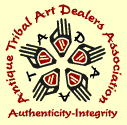| Of all the baskets of the southwest region , early three rod coiled Apache baskets of the
Western Apache and Yavapai Apache are the most collectible.
While coarse twined burden baskets are still woven today, Apache fine coiled willow basketry on the
three rod foundation died with the Great Depression of the 1930's. A number of influences converged at this time.
Tourism to the Southwest slowed. The basket collectors market dropped off as wealthy collectors bought up existing
collections of basketry from "less liquid" collectors. The Industrial Revolution produced cheap
pots and pans so labor intensive basketry was no longer practical or necessary culturally. Apache children were
sent to government schools and discouraged from traditional weaving.
An artform perfected over thousands of years was lost in a decade as weavers took up new lines of work
. Generally, only the relatively quickly made open weave single rod burden baskets continued to be made for the tourist industry.
When the economy and interest in basket collecting returned after World War II, fine three rod coiled
basketry had disappeared; there was no economic incentive to spend months weaving fine basketry in the new inflationary
economy.For these reasons , all the Apache baskets listed on our website--unless otherwise specified--date from approx.
1875/1885 (the beginning of the collector period) through 1930 (the end of fine coiled basketry.) |
Visually , Apache baskets are striking with strong contrast in color and bold geometric
or pictorial (less common) motifs . Being on a three rod foundation makes the baskets tight, stiff and sturdy with
no bend to them, and yields rounded well-defined coils that stand out. (By contrast, Pima baskets of Southern
Arizona which use the same external willow and martynia are coiled on a grass bundle foundation yielding "flatish"
coils.) Pimas --which are also relatively more common and were somewhat more quickly made than the Apaches--often run
about one-third the price of a similar size, form and weave of the more desired Apache. Mint, early Pima trays might
start in the mid hundreds with the best mint Apache trays starting in the low thousands.
Plant materials used by Apache weavers
Willow shoots -- sized, peeled (whitish originally, patinated to golden tan /light brown in all early
examples). Rarely, sunburnt willow is used in decoration.
Martynia/devilsclaw seed pod --black/dark brown;used in design
Yucca root--used sparingly in a small percentage of Apache baskets; brick red in color. |

